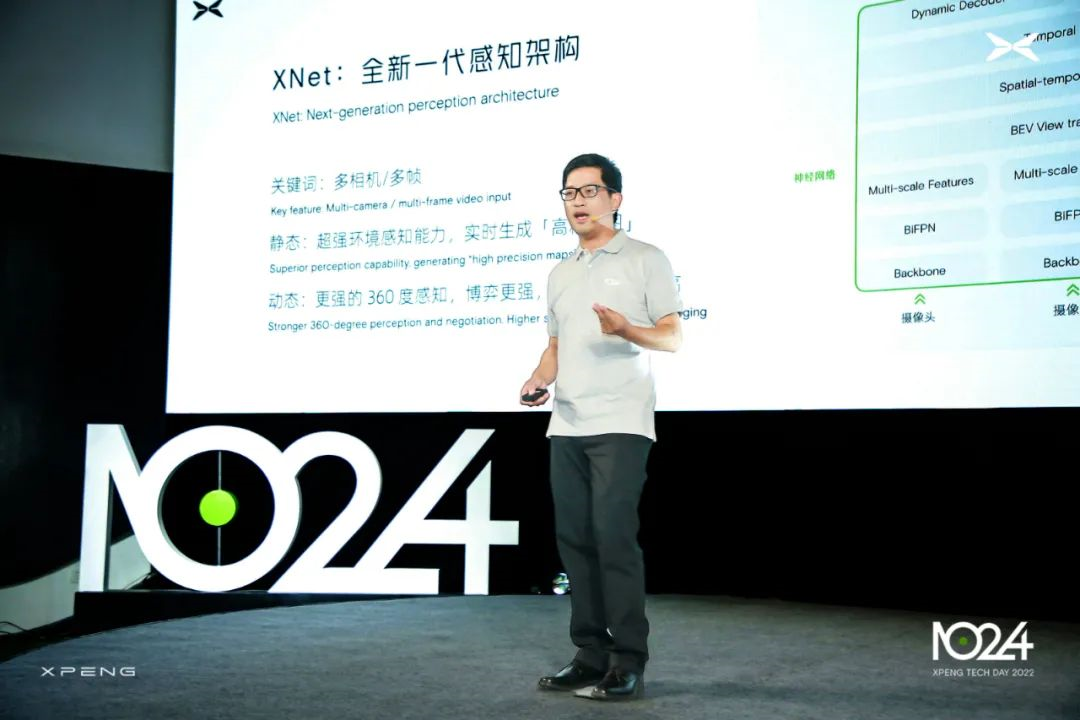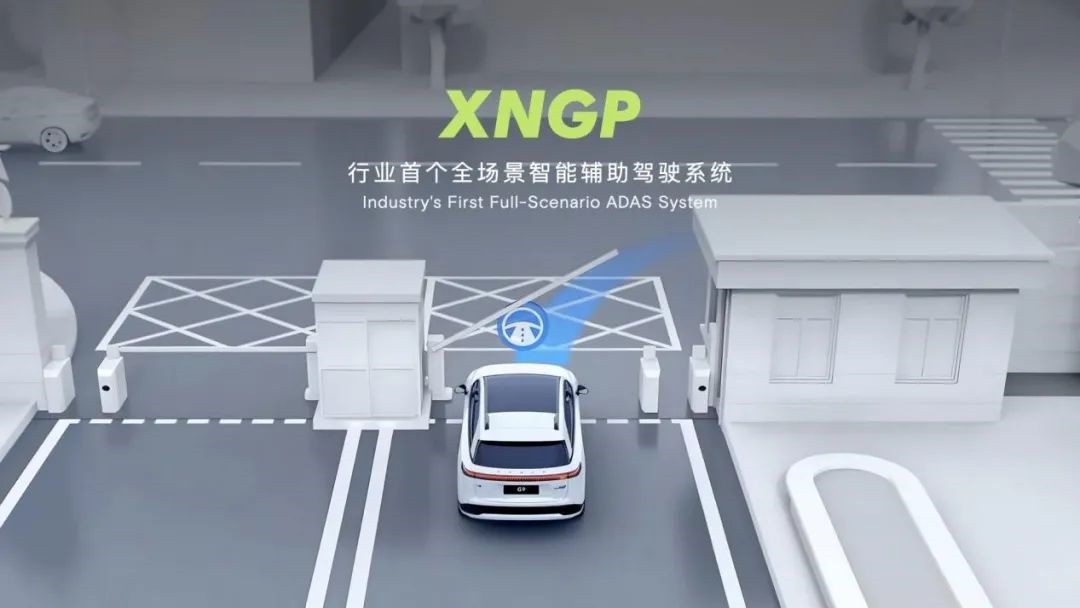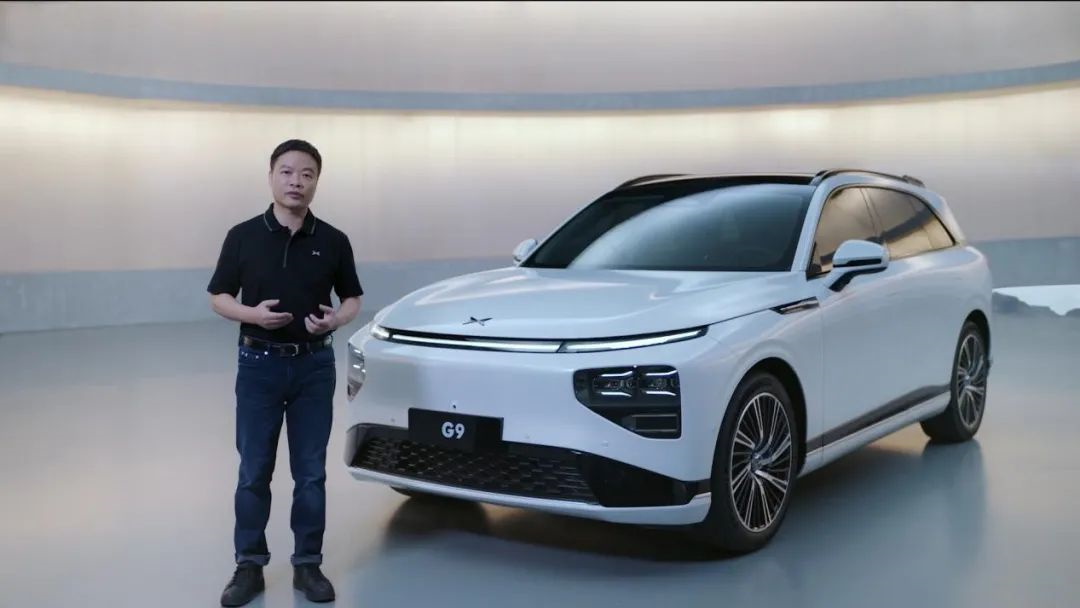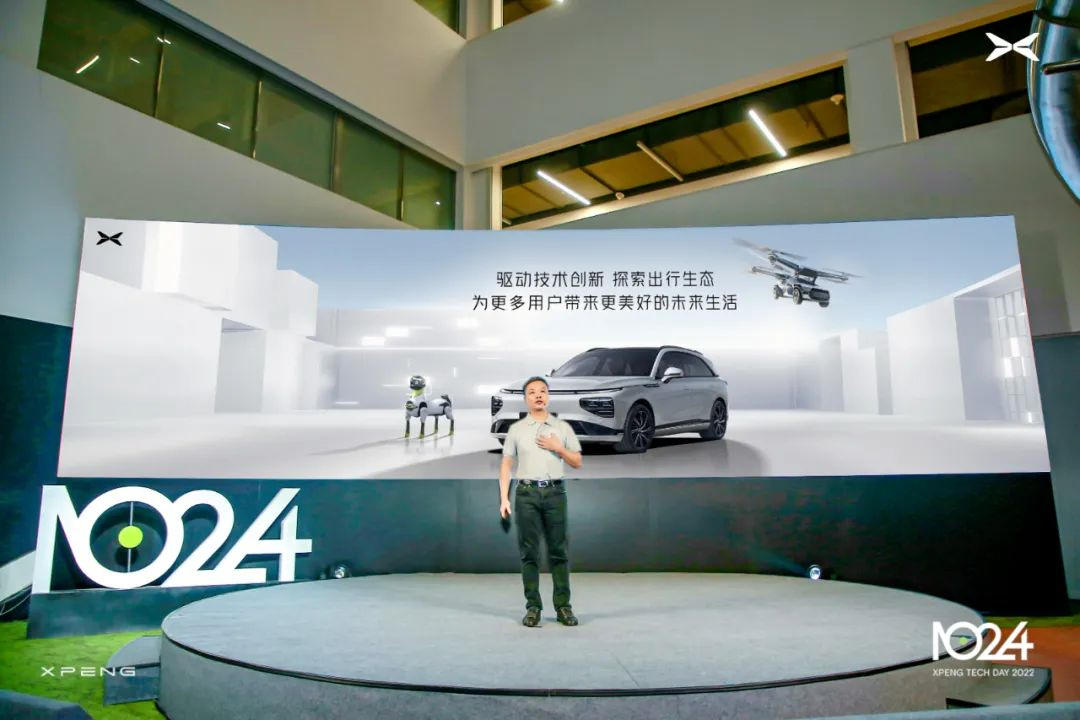Article by Zheng Wen
Edited by Zhou Changxian
On one side is fire, and on the other is seawater. XPeng Motors, a company that has been in operation for eight years, is in great turmoil.
On October 24th, the annual “1024 XPeng Automotive Technology Day” was held at the XPeng Motors Guangzhou Headquarters as scheduled. Within 70 minutes, XPeng Motors founder He XPeng and Vice President of Autonomous Driving, Dr. Wu Xinzhou, successively announced the latest developments in the four fields of intelligent driving, intelligent interaction, intelligent robots, and flying cars.
On stage, the two executives proudly revealed their insider information, frequently prompting applause and cheers from the audience below. At the end of the press conference, car owners rushed up to take photos with He XPeng, causing a scene of chaos.
For a moment, it seemed that people had forgotten about the G9 incident that had occurred a month ago, the ongoing organizational restructuring, and the stock price that had fallen to an all-time low in the capital market.
It is well known that He XPeng, born in 1977, is embarking on his second venture. When his first business, UC Youshi, was acquired by Alibaba, he became financially independent. Later on, He XPeng entered the automotive industry, drawn by the opportunity to electrify and modernize it.
In eight years, He XPeng has transformed from an internet entrepreneur to an automotive tycoon, ushering XPeng Motors into a new phase of development.
From a positive perspective, XPeng Motors has been leading the trend in intelligentization with years of technological accumulation, and is one of only a few car companies that produce urban intelligent-driving cars. From a negative standpoint, XPeng Motors’ research and development costs remain high, and its sales have been lower than expected even in the face of intense competition, revealing the weaknesses in its organizational structure.
In He XPeng’s words, XPeng Motors is navigating a bend in the road.
Urban Intelligent Driving: Conquering the Heights of Autonomous Driving
On September 17th, during a typical weekend morning, XPeng Motors announced that the urban NGP (Navigation Guidance Pilot) was beginning to be tested. As part of the third OTA (over-the-air) upgrade for the XPeng P5, some Guangzhou P5 car owners who had submitted intelligent driving suggestions were randomly invited to participate in the test.This seems to be a trivial matter. But “urban intelligent driving” is the next high ground for competition in the autonomous driving industry, and XPeng Motors has become one of the first automakers to lay the groundwork.
As early as 2017, Waymo released a message that “we have solved 99% of the problems with autonomous driving, and only need to start the car.” At the Baidu AI Developers Conference that year, Li Yanhong rode in a retrofitted autonomous driving car and drove to the venue with both hands off the steering wheel.
At that time, it seemed like the spring breeze had already blown in. However, until today, commercialization is still a major challenge. Therefore, scene segmentation and phased achievement of partial goals have become industry consensus. And “urban intelligent driving” is the top priority at present.

Wu Xinzhou constantly emphasizes the significance of urban scenarios for the development of intelligent driving. Data shows that urban roads account for as much as 71% of users’ total vehicle mileage, and up to 90% when measured by usage time. At the same time, only 25% of users travel on highways every day, while city roads make up 100%.
Currently, only three passenger car companies have announced mass production, with XPeng Motors being one of them, while the other two are ARCFOXxiong (Huawei) and Weipai (Halo Intelligent Driving). The current situation is that Weipai’s NOH has not yet been released, while ARCFOXxiong’s urban smart driving solution NCA has achieved large-scale implementation. Huawei and XPeng Motors both adopt the technology route of multi-sensor fusion + high-precision maps.
On October 24th, at the “1024 XPeng Motors Technology Day”, XPeng Motors further shared the latest details of its achievements in intelligent driving. From the sharing, it can be seen that XPeng Motors’ latest strategy is “heavy perception, light maps”.One objective reality is that the layout of high-definition maps faces challenges such as difficult qualification and reexamination, large-scale survey data collection, frequent updates of road information, and various sensitive road data policies, which impede the practical applications of high-definition maps at every step.

XPeng Motors’ solution is to strengthen the competitiveness of the new generation XNGP intelligent driving assistance system in software architecture, AI, and data system.
The new technology architecture employed in XPeng Motors’ urban NGP and LCC enhanced version offers all-round improvements in positioning, sensing, prediction, regulation and control. Compared to the high-speed NGP, the urban NGP has increased the code volume by six times, the perception model quantity by four times, and the prediction/planning/control-related code by 88 times.
At present, the urban NGP has reached 84% user penetration and 63% mileage penetration rates, with a pass-through efficiency close to human drivers at 90%. The number of driver takeovers per one hundred kilometers of passive takeover is only 0.6 times. It can be said that the urban NGP has become the best companion for users’ daily commutes.
Recently, “AutocarMax/Travel 100” conducted a long-distance test of the P5 equipped with the urban NGP in Guangzhou. Starting from XPeng Zhuhui Park in Tianhe District, the P5 underwent multiple complicated scenarios such as offset intersections, sharp curves, and main road convergence. Whether it was lane changing overtaking, emergency obstacle avoidance, or going through a yellow light, the P5 performed nearly flawlessly, almost without the need for driver takeover.
It is understood that the XNGP intelligent driving assistance system equipped on XPeng G9 has even more advantages, possessing all-scenario intelligent driving assistance capabilities, and represents the ultimate technology form of assisted driving before achieving autonomous driving.It not only doesn’t require high-precision maps, but also can be used in cities and road sections across the country. At the same time, it can cover daily commuting and seamlessly connect various scenarios such as highways, urban fast roads, and underground parking lots, to ensure a non-stop experience. In terms of safety, road game ability, and passing efficiency, XNGP’s performance will exceed that of most drivers, with close-to-zero handover on highways and urban expressways.
According to Wu Xinzhou, data collection, annotation, training, and deployment are the four core capabilities that are very important. To fulfill these capabilities, XPeng Motors has chosen to enhance its fusion strength.
For example, in terms of multi-sensor fusion, XNet deep visual neural network combines data from multiple cameras through multi-frame temporal front-end fusion to output the 4D information of dynamic target objects (such as the size, distance, position, speed, behavior prediction, etc. of vehicles, motorcycles, etc.) under the BEV perspective.
In the past, XPeng Motors’ visual perception architecture was handwritten logic, and the data needed to be manually annotated. Now it has been replaced by a neural network, and the efficiency has been greatly improved. Wu Xinzhou revealed that what used to take 2,000 people one year to annotate can now be completed in 16.7 days.
Companies that perform well in autonomous driving technology now use neural networks to replace manual annotation, and in the training stage, some companies also tend to combine directional collection and “simulation” to solve corner cases (extreme scenarios). XPeng Motors has now reached a considerable level of technical level.
Under the high efficiency brought by the software and hardware system, the XNGP system will be able to recognize traffic lights and pass through intersections in all non-mapped cities in the country. In addition to G9 Max version models featuring NGP, Memory Parking, LCC, and Smart Parking, the system will also cover Guangzhou, Shenzhen, and Shanghai with City NGP functions by the first half of 2023.
In the second half of 2023, most non-graphical cities will open up their lane changing, overtaking, and turning capabilities (certain higher-level capabilities will be gradually opened based on user numbers and testing progress). By 2024, the entire scene will be interconnected, achieving intelligent navigation and assisted driving capabilities from parking space to parking space. In addition, for XPILOT users, the intelligent assisted driving capabilities of XPeng Motors will continue to be updated.
Recently, XPeng Motors has achieved a breakthrough by successfully passing closed-field autonomous driving tests and obtaining a license for intelligent connected vehicle road testing. G9 has become the industry’s first mass-produced vehicle that has passed closed-field autonomous driving tests and obtained “Intelligent Connected Vehicle Road Testing” license only by upgrading its automatic driving software without changing its hardware.
Wu Xinzhou once said, “If we can achieve a high penetration rate of NGP in urban scenarios, it may cause quantitative changes which lead to qualitative changes.”
However, even if this qualitative change becomes a reality soon, it will be difficult to solve the pain of XPeng Motors today. At present, what it urgently needs is another remedy.
Reform: The Only Way to Break Through Difficulties
From the pace, the three “swords” of “NIO, XPeng, and Ideals” are generally synchronous. NIO took the lead, followed closely by XPeng, while Ideals caught up later. All of them have achieved a phased success from 0 to 1. At this stage, their competitiveness is based on “services”, “intelligence”, and “family”, and the labels are clear.
From G3 to P7, to G3i, then to P5, and finally to the latest G9, every “industry-first” technology of XPeng Motors marks its commitment in the field of intelligence.P7 is equipped with an automatic parking system that is best suited for Chinese parking scenarios, and its precise control of the full-scene voice system has brought the intelligent cockpit to a new level. The newly added Navigation Guided Pilot (NGP) intelligent navigation assisted driving function on the P5 has left behind many of its peers.

Nowadays, “intelligence” is not only firmly attached to our products, but it has also become the DNA of XPeng Motors.
But is this enough? The answer is no. If it were, XPeng Motors would have already entered a virtuous cycle. In fact, this start-up company is full of crises. Among its several products, only the P7 is truly popular; in terms of marketing, XPeng is not the most proficient one among similar companies; and in terms of brand building, its methods are erratic and unsatisfactory.
The urgent task for XPeng Motors to break through its difficulties is to make up for its shortcomings.
After the launch of the L9, Li Xiang, the founder of Ideanomics, said that in the future, the ability to obtain systematic and complex organization would be required. “How to keep everyone working more efficiently in one world is really harder than managing large Internet companies, which is the biggest challenge we face next.”
This statement is prescient. However, it is not Ideanomics but XPeng, who has more products and a better intelligence, that has fallen into a predicament.
After the launch of P7, the industry’s general evaluation was that XPeng Motors had already hit the road on car manufacturing. However, the company’s subsequent performance left people puzzled.The highly anticipated G9 had a difficult start. The confusion in its product configuration not only led to the dissatisfaction of potential customers but also raised doubts about the system capability of XPeng from both external and internal perspectives. Although XPeng himself made an effort in renaming and adjusting the pricing and configuration of G9, such blatant issues have proven that restructuring the organizational framework of XPeng is imperative.
In fact, the chaos had already surfaced, and this time it erupted in a concentrated manner.
The sales volume of the market presents a very intuitive picture. In September, XPeng delivered a total of 8468 new vehicles, of which P7 accounted for the main sales volume with 4634 deliveries, but its update cycle is relatively slow. XPeng P5 delivered 2417 vehicles, falling short of expectations. XPeng G3i delivered 1233 vehicles, while XPeng G9 completed the first batch of deliveries with 184 vehicles. In the first three quarters, XPeng delivered less than 100,000 vehicles, only achieving 39% of its annual sales target of 250,000 vehicles.
In the capital market, XPeng’s performance is even more disappointing. Compared with the beginning of the year, its stock price has dropped by 80%, evaporating a market value of over 200 billion yuan.
People are wondering whether the success of P7 is the result of systematic crystallization or just luck. Without the support of a few strong product matrices and sales scale, can XPeng’s technological R&D capacity in intelligentization be anything more than empty talk? To put it further, how can XPeng effectively land its leading intelligent technology, and sell products well, service users well and shape the brand well in the jungle with fierce competition?
Undoubtedly, the construction of complex system force is XPeng’s new challenge.
Elon Musk once intuitively described his feelings during his entrepreneurial process: chewing glass, staring into an abyss. Glass represents his own mistakes, while the abyss is the failure that must be faced directly.# XPeng Motors, just like He XPeng himself
On October 21, XPeng Motors made significant adjustments to its operations, organizational structure, and product strategy, establishing five virtual committees to enhance communication channels and improve collaboration efficiency across different business lines.

He XPeng announced the comprehensive adjustment of the organizational structure and the establishment of five virtual committees and three product matrix organizations. The former is responsible for improving communication and cooperation among various business lines, while the latter is tasked with establishing the end-to-end product business closed loop.
The five virtual committees are the Strategic Committee, Production Regulation Committee, Technical Planning Committee, Production and Sales Balance Committee, and OTA Committee. He XPeng is personally in charge of the strategic, production regulation, and technical committees. The three product matrix organizations are E Platform, F Platform, and H Platform, and the leaders of the three are all accountable directly to He XPeng. This structure flattens the company, greatly enhances its agility and adaptability to market changes.
Lei Jun, founder of Xiaomi, once told He XPeng that “making a hardware and software combination product is a balancing art.”
Until today, XPeng Motors is still trying to solve this problem. “When making products on the internet, we have to strive for perfection. However, when making hardware and software products, we have to consider balance and avoid any significant shortcomings. So, the biggest challenge in vehicle production today is finding the differences while maintaining balance,” He XPeng said.
Previously, He XPeng realized that producing cars was different from making internet products. The company must adhere to the “barrel theory,” which means that when there are strong points, there can’t be any significant weaknesses. After the G9 incident, he acquired new knowledge: it is necessary to balance, prioritize and make choices.
After eight years of entrepreneurship, XPeng Motors has achieved staged success. Now, as the company enters the bend, it must learn to transition from a personalized startup to a mature company.It is interesting that, as reported by Automotive Industry News this morning, Geely is also undertaking a major strategic adjustment, focusing on its core automobile business and strengthening strategic coordination.
To enhance synergy and improve efficiency among its various brands and business units, Geely will also be making synchronous adjustments to its entire organizational structure. The Geely Holding Group will set up committees for change and innovation, product and technology collaboration, supply chain collaboration, and brand building.
XPeng and Geely, one new and one old, though they differ in size and development stage, are both struggling to make strategic adjustments. Perhaps this is the gift of the times.
Steve Jobs once asked himself, “If today were the last day of my life, would I still want to do what I am about to do today?” He XPeng has given the same answer to this question: “I would still insist on everything I have ever insisted on.”
We believe that this statement is enough to keep He XPeng committed to certain things, and to lead XPeng Motors through the current haze and into a bright future.
This article is a translation by ChatGPT of a Chinese report from 42HOW. If you have any questions about it, please email bd@42how.com.
